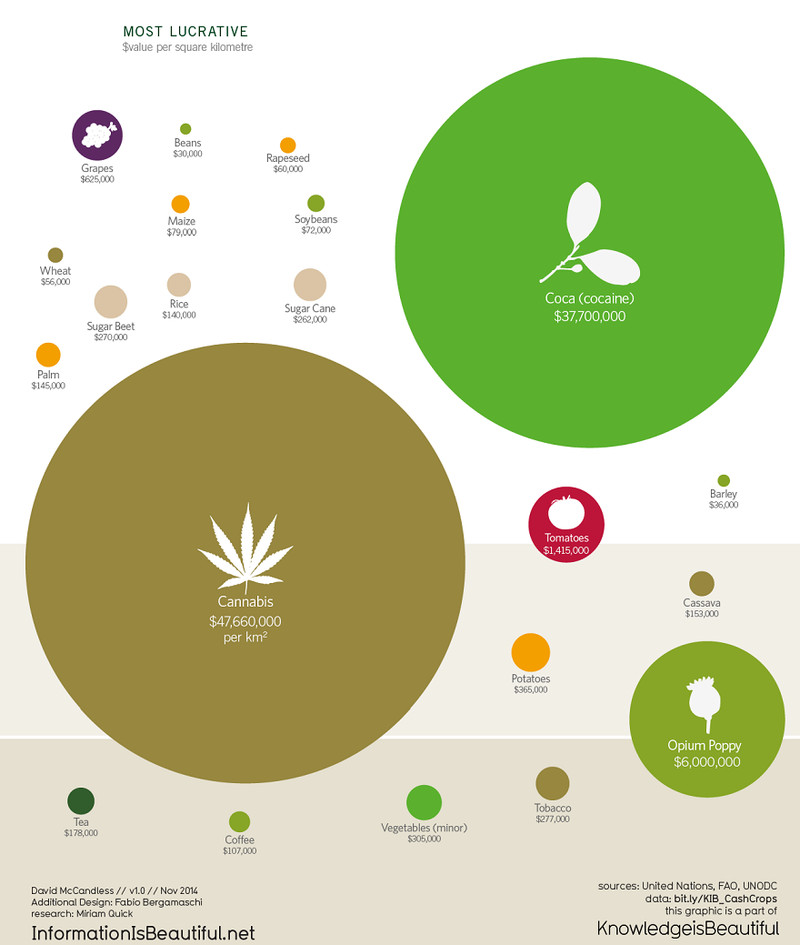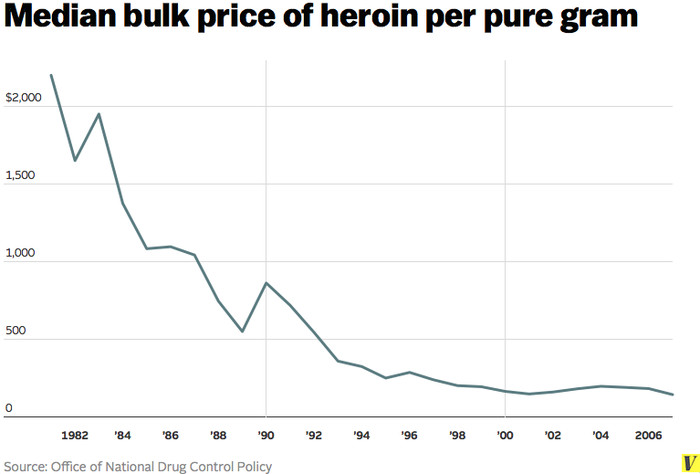poledriver
Bluelighter
- Joined
- Jul 21, 2005
- Messages
- 11,543
The ridiculous profitability of illegal drugs, in one chart
The illicit drug market is immensely profitable — lucrative enough to finance the violent activities of criminal organizations around the world, particularly drug cartels in Latin America.
This graphic, from the team at Information Is Beautiful, charts out just how valuable illegal drugs are compared to other crops:

The authors acknowledge that illicit drug prices are very difficult to gauge, so some estimates are made for cannabis (marijuana), coca (cocaine), and opium poppy (heroin and other opiates). But the available data gives a rough idea of how profitable illicit drugs can be.
Much of this high value is caused by the war on drugs. Prices are increased to reflect the difficulty of shipping drugs from Latin America to major markets in the US and rest of the world, since entire harvests can be lost at the hands of drug-busting government officials or rival criminal organizations. But in a perverse way, this inflated cost actually encourages criminal organizations to get into the businesses of drugs — they might lose some of their product along the supply chain, but any product that makes it through is immensely profitable.
The prices of illicit drugs would very likely plummet if any of them were legalized. That's why Mark Kleiman, drug policy expert at UCLA, expects the cost of producing and shipping marijuana to drop to match other crops, such as tobacco or tea, following marijuana legalization. That would help run many criminal organizations, which can't compete with the lower prices, out of business, but it could also lead to the increased access and commercialization of marijuana.
Is the war on drugs succeeding?
The goal of the war on drugs is to reduce drug use. If the campaign against drug dealers and producers were succeeding, drugs would become scarcer and prices would increase. Yet the data show just the opposite occurring.
The prices of most drugs, as tracked by the Office of National Drug Control Policy, have plummeted. Since 1981, the median bulk price of heroin is down by roughly 93 percent, and the median bulk price of powder cocaine is down by about 87 percent. Since 1986, the median bulk price of crack cocaine fell by around 44 percent. The prices of meth and marijuana, meanwhile, have remained largely stable since the 1980s.

Read the whole article -
http://www.vox.com/xpress/2014/11/10/7175859/marijuana-legalization-heroin-cocaine-crops
The illicit drug market is immensely profitable — lucrative enough to finance the violent activities of criminal organizations around the world, particularly drug cartels in Latin America.
This graphic, from the team at Information Is Beautiful, charts out just how valuable illegal drugs are compared to other crops:

The authors acknowledge that illicit drug prices are very difficult to gauge, so some estimates are made for cannabis (marijuana), coca (cocaine), and opium poppy (heroin and other opiates). But the available data gives a rough idea of how profitable illicit drugs can be.
Much of this high value is caused by the war on drugs. Prices are increased to reflect the difficulty of shipping drugs from Latin America to major markets in the US and rest of the world, since entire harvests can be lost at the hands of drug-busting government officials or rival criminal organizations. But in a perverse way, this inflated cost actually encourages criminal organizations to get into the businesses of drugs — they might lose some of their product along the supply chain, but any product that makes it through is immensely profitable.
The prices of illicit drugs would very likely plummet if any of them were legalized. That's why Mark Kleiman, drug policy expert at UCLA, expects the cost of producing and shipping marijuana to drop to match other crops, such as tobacco or tea, following marijuana legalization. That would help run many criminal organizations, which can't compete with the lower prices, out of business, but it could also lead to the increased access and commercialization of marijuana.
Is the war on drugs succeeding?
The goal of the war on drugs is to reduce drug use. If the campaign against drug dealers and producers were succeeding, drugs would become scarcer and prices would increase. Yet the data show just the opposite occurring.
The prices of most drugs, as tracked by the Office of National Drug Control Policy, have plummeted. Since 1981, the median bulk price of heroin is down by roughly 93 percent, and the median bulk price of powder cocaine is down by about 87 percent. Since 1986, the median bulk price of crack cocaine fell by around 44 percent. The prices of meth and marijuana, meanwhile, have remained largely stable since the 1980s.

Read the whole article -
http://www.vox.com/xpress/2014/11/10/7175859/marijuana-legalization-heroin-cocaine-crops
